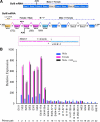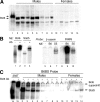Male-specific hepatic Bcl6: growth hormone-induced block of transcription elongation in females and binding to target genes inversely coordinated with STAT5
- PMID: 19797429
- PMCID: PMC2775936
- DOI: 10.1210/me.2009-0242
Male-specific hepatic Bcl6: growth hormone-induced block of transcription elongation in females and binding to target genes inversely coordinated with STAT5
Abstract
The transcriptional repressor Bcl6 is a male-specific rat liver gene product and one of 24 early GH-response genes encoding DNA-binding proteins. Presently, the sex specificity of Bcl6 was shown to emerge at puberty, when hepatic Bcl6 mRNA was induced in males and repressed in females by the female plasma GH profile. Hepatic Bcl6 mRNA was increased to near-normal male levels in hypophysectomized females and was extinguished in intact males given a continuous GH infusion (female-like GH pattern). Bcl6 was also repressed in adult male somatostatin-deficient mice, where plasma GH profiles are female like. Hepatic Bcl6 RNA was rapidly down-regulated by GH pulse treatment, both in hypophysectomized male rats and in primary rat hepatocytes. Bcl6 was substantially induced in female mice deficient in hepatic signal transducer and activator of transcription (STAT)5a/STAT5b, suggesting that these STAT transcriptional mediators of GH signaling repress Bcl6. Indeed, STAT5 was bound to Bcl6 STAT5-binding region-B, previously associated with Bcl6 repression, in both male and female liver chromatin. STAT5 also bound to Bcl6 region-A in male chromatin but only during a plasma GH pulse. Analysis of primary transcripts (heterogeneous nuclear RNA) across the Bcl6 gene revealed a novel mechanism of GH-dependent sex specificity, with two apparent blocks in Bcl6 transcription elongation seen in female liver and in continuous GH-treated male liver, one early in intron 4 and one in exon 5, which together reduced transcription beyond exon 5 more than 300-fold. Finally, Bcl6 was bound to a subset of STAT5-binding sites in male liver chromatin, including a Socs2 STAT5-binding site where Bcl6 binding increased substantially between plasma GH pulses, i.e. when STAT5 binding was low. Bcl6 and STAT5 binding are thus inversely coordinated by the endogenous pulses of pituitary GH release, suggesting this male-specific transcriptional repressor modulates hepatic GH signaling to select STAT5 target genes.
Figures








Similar articles
-
Characterization of three growth hormone-responsive transcription factors preferentially expressed in adult female liver.Endocrinology. 2007 Jul;148(7):3327-37. doi: 10.1210/en.2006-1192. Epub 2007 Apr 5. Endocrinology. 2007. PMID: 17412818 Free PMC article.
-
Dynamic, sex-differential STAT5 and BCL6 binding to sex-biased, growth hormone-regulated genes in adult mouse liver.Mol Cell Biol. 2012 Feb;32(4):880-96. doi: 10.1128/MCB.06312-11. Epub 2011 Dec 12. Mol Cell Biol. 2012. PMID: 22158971 Free PMC article.
-
Activation of Male Liver Chromatin Accessibility and STAT5-Dependent Gene Transcription by Plasma Growth Hormone Pulses.Endocrinology. 2017 May 1;158(5):1386-1405. doi: 10.1210/en.2017-00060. Endocrinology. 2017. PMID: 28323953 Free PMC article.
-
Growth hormone pulse-activated STAT5 signalling: a unique regulatory mechanism governing sexual dimorphism of liver gene expression.Novartis Found Symp. 2000;227:61-74; discussion 75-81. doi: 10.1002/0470870796.ch5. Novartis Found Symp. 2000. PMID: 10752065 Review.
-
Pulsatility of growth hormone (GH) signalling in liver cells: role of the JAK-STAT5b pathway in GH action.Growth Horm IGF Res. 2000 Apr;10 Suppl B:S1-8. doi: 10.1016/s1096-6374(00)80002-7. Growth Horm IGF Res. 2000. PMID: 10984246 Review.
Cited by
-
Important Hormones Regulating Lipid Metabolism.Molecules. 2022 Oct 19;27(20):7052. doi: 10.3390/molecules27207052. Molecules. 2022. PMID: 36296646 Free PMC article. Review.
-
Somatostatin and its receptors contribute in a tissue-specific manner to the sex-dependent metabolic (fed/fasting) control of growth hormone axis in mice.Am J Physiol Endocrinol Metab. 2011 Jan;300(1):E46-54. doi: 10.1152/ajpendo.00514.2010. Epub 2010 Oct 13. Am J Physiol Endocrinol Metab. 2011. PMID: 20943754 Free PMC article.
-
Adverse drug reactions among major depressive disorders: patterns by age and gender.Heliyon. 2021 Dec 22;7(12):e08655. doi: 10.1016/j.heliyon.2021.e08655. eCollection 2021 Dec. Heliyon. 2021. PMID: 35005292 Free PMC article.
-
Distinct roles of androgen receptor, estrogen receptor alpha, and BCL6 in the establishment of sex-biased DNA methylation in mouse liver.Sci Rep. 2021 Jul 2;11(1):13766. doi: 10.1038/s41598-021-93216-6. Sci Rep. 2021. PMID: 34215813 Free PMC article.
-
Transcriptomic Analysis of Rat Macrophages.Front Immunol. 2021 Feb 1;11:594594. doi: 10.3389/fimmu.2020.594594. eCollection 2020. Front Immunol. 2021. PMID: 33633725 Free PMC article.
References
-
- Clodfelter KH, Holloway MG, Hodor P, Park SH, Ray WJ, Waxman DJ 2006 Sex-dependent liver gene expression is extensive and largely dependent upon signal transducer and activator of transcription 5b (STAT5b): STAT5b-dependent activation of male genes and repression of female genes revealed by microarray analysis. Mol Endocrinol 20:1333–1351 - PubMed
-
- Jansson JO, Edén S, Isaksson O 1985 Sexual dimorphism in the control of growth hormone secretion. Endocr Rev 6:128–150 - PubMed
-
- MacLeod JN, Pampori NA, Shapiro BH 1991 Sex differences in the ultradian pattern of plasma growth hormone concentrations in mice. J Endocrinol 131:395–399 - PubMed
Publication types
MeSH terms
Substances
Grants and funding
LinkOut - more resources
Full Text Sources
Molecular Biology Databases
Miscellaneous

